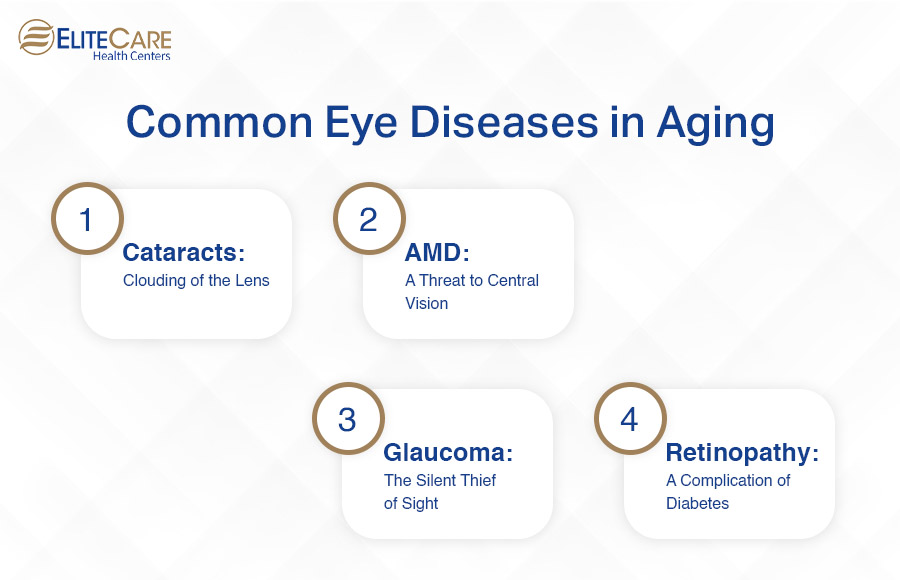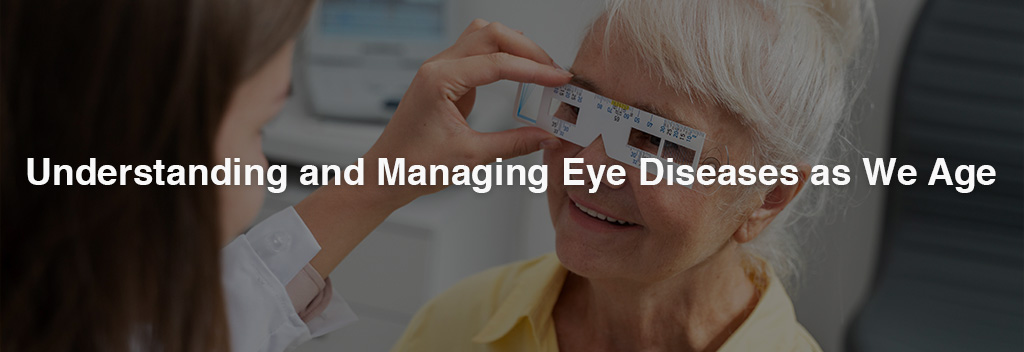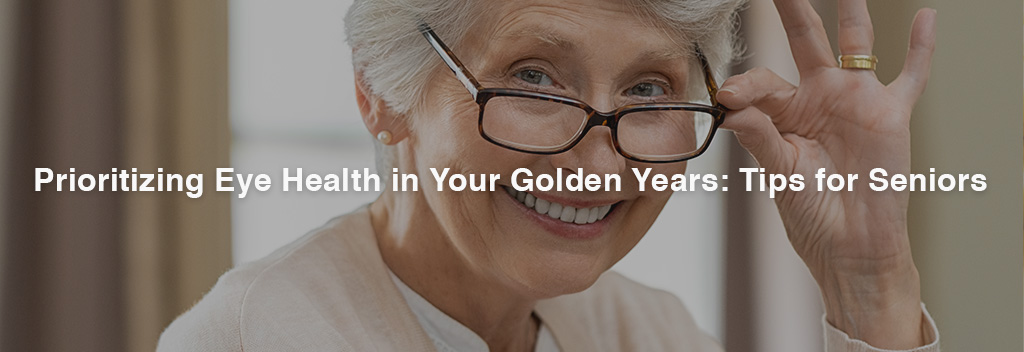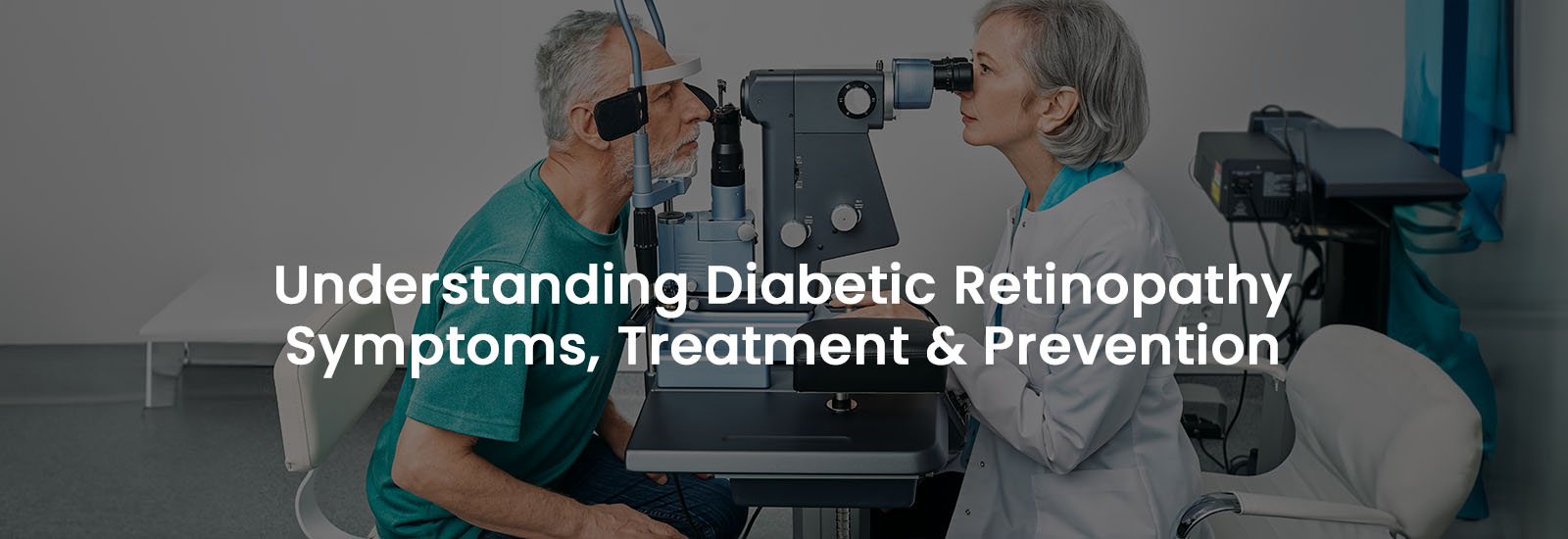
Age-related eye diseases are a normal, if not inevitable, aspect of life. Age increases the risk of eye disorders, making it more important to understand these conditions to maintain eye health and good vision.
While certain eye conditions in the elderly are just irritating, others are serious illnesses that, if ignored, might result in irreversible blindness. The secret to effective treatment? Early detection. Schedule routine eye exams and keep an eye out for age-related vision issues.
Age-Related Changes in the Eyes
As we age, several physiological changes occur in the eyes. These changes contribute to an increased susceptibility to various eye diseases.
It is crucial to comprehend these changes in order to identify and treat age-related eye disorders.
1. Presbyopia: The Inevitable Aging of the Lens
The aging process naturally results in presbyopia, which impairs the eye’s ability to focus on close objects. It usually shows up around the age of forty, at which point bifocals or reading glasses become necessary. Understanding the causes of presbyopia and the available treatments can help people adjust to this typical age-related condition.
2. Changes in Tear Production and Dry Eyes
Aging often leads to a reduction in tear production and changes in tear composition, resulting in dry eyes. The decreased quantity and quality of tears can lead to discomfort and irritation.
3. Changes in Pupil Size and Reactivity
With age, the muscles controlling pupil size and reactivity become less responsive. The pupils may also become smaller and react more slowly to changes in light.
Common Eye Diseases in Aging
Several eye diseases become more prevalent as individuals age, significantly impacting vision and quality of life.

1. Cataracts: Clouding of the Lens
Cataracts are a leading cause of vision impairment in older adults. In this, the vision becomes blurry due to the clouding of the clear lens inside the eye. The main risk factor is age, but there are other factors as well, such as smoking, diabetes, prolonged UV radiation exposure, as well as certain drugs.
Surgery is typically used to replace the clouded lens with an artificial one to treat cataracts. Technological developments in surgery, such as laser-assisted cataract surgery, have led to better results and shorter recuperation periods.
2. Age-Related Macular Degeneration (AMD): A Threat to Central Vision
AMD is a progressive condition affecting the macula, the central part of the retina that provides crisp central vision. A diet deficient in antioxidants, smoking, aging, and heredity are significant risk factors for AMD.
Although AMD cannot be cured, certain medications and treatments, like anti-VEGF injections, can delay the disease’s course. It’s also advised to make lifestyle changes, such as eating a diet high in antioxidants and wearing protective eyewear.
3. Glaucoma: The Silent Thief of Sight
Often referred to as the “silent thief of sight,” glaucoma is a group of eye conditions that can lead to optic nerve damage and vision loss. It is often associated with elevated intraocular pressure. Glaucoma risk factors include aging, family history, and certain medical disorders.
The goal of glaucoma treatment is to lower intraocular pressure by drugs, laser therapy, or surgery. To prevent irreversible vision loss, glaucoma must be detected and managed regularly.
4. Diabetic Retinopathy: A Complication of Diabetes
A consequence of diabetes that results from damage to the blood vessels in the retina is called diabetic retinopathy. Diabetes and persistently elevated blood sugar levels increase the risk of this eye condition in the elderly. It can lead to blindness if left untreated.
Controlling blood sugar levels strictly is necessary for the treatment of diabetic retinopathy. To treat issues and maintain vision, doctors may even advise laser therapy, injections, and surgical procedures.
Prevention and Lifestyle Modifications
While some age-related eye diseases are inevitable, adopting a healthy lifestyle and taking preventive measures can significantly reduce the risk and severity of certain conditions.
1. Nutritional Strategies for Eye Health
Maintaining eye health requires a diet high in vitamins, minerals, and antioxidants that are well-balanced. A number of nutrients, including zinc, omega-3 fatty acids, and vitamins A, C, and E, support eye health and may help avoid conditions like age-related macular degeneration (AMD).
Foods Beneficial for Eye Health
- Leafy green vegetables
- Fatty fish
- Citrus fruits
- Nuts and seeds
- Carrots and sweet potatoes
2. Regular Eye Exams: A Key to Early Detection
For the early detection of eye problems and timely intervention, routine eye exams are crucial. Comprehensive eye exams should be performed on adults over 40 at least every two years; more regular examinations may be necessary for people with pre-existing eye disorders or risk factors.
3. Lifestyle Modifications for Healthy Eyes
Long-term exposure to UV radiation increases the risk of cataract development as well as other eye disorders. Sunglasses with UV protection assist shield the eyes from damage. Wide-brimmed hats also offer more protection when worn outside. Its important to protect your vision as you age.
Smoking poses a serious risk for several eye conditions, such as age-related macular degeneration and cataracts. Giving up smoking has positive effects on general health as well as eye health.
Diabetes and high blood pressure are two diseases that might affect eye health. Complications such as diabetic and hypertensive retinopathy can be avoided by managing these disorders with appropriate medical care, medication, and lifestyle modifications.
Technological Advancements in Eye Care
Advancements in technology have revolutionized the field of eye care, offering new and improved methods for diagnosing and treating age-related eye diseases.
1. Artificial Intelligence in Eye Disease Diagnosis
Artificial intelligence (AI) has completely changed the way that diseases are identified and diagnosed in the field of eye care. To enable early intervention and prevent vision loss, artificial intelligence (AI) systems can analyze retinal images for indicators of diseases like diabetic retinopathy.
2. Telemedicine in Ophthalmology
People can easily and conveniently consult with eye care specialists using telemedicine. Timely management of ocular disorders is made possible via remote monitoring and virtual consultations, especially for individuals who might find it difficult to access traditional healthcare services.
As we age, understanding the changes occurring in our eyes and being proactive in managing eye health becomes increasingly important.
This comprehensive guide has provided insights into common age-related eye diseases, preventive measures, lifestyle modifications, and advancements in eye care technologies. By staying informed and taking proactive steps, individuals can optimize their eye health and maintain clear vision well into their golden years.
For any vision-related concerns, consult with a trusted primary care physician. Contact EliteCare Health Centers, one of the finest healthcare centers in Florida to learn more. Schedule an appointment with a board-certified primary care physician and explore a wide range of senior care services, including annual physical exams and preventive care.
Frequently Asked Questions
The most common age-related eye diseases include cataracts, age-related macular degeneration (AMD), glaucoma, and diabetic retinopathy.
Adults over the age of 40 should have comprehensive eye exams at least every two years.
Yes, a balanced diet rich in vitamins, minerals, and antioxidants is crucial for maintaining eye health. Nutrients such as zinc and omega-3 fatty acids contribute to the health of the eyes.
Prolonged exposure to ultraviolet (UV) light can increase the risk of cataracts and other eye conditions.





